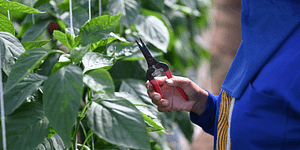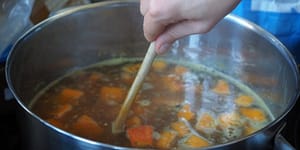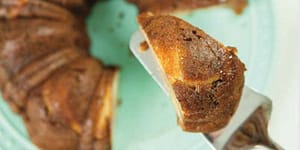Permaculture Q&A: Perennial Plants for Temperate Climates

Our award winning author Eric Toensmeier (Perennial Vegetables, Paradise Lot), and two authors from our UK publishing partner Permanent Publications, Anni Kelsey (Edible Perennial Gardening) and Stephen Barstow (Around the World in 80 Plants), unanimously agree that perennial plants are perfect for cold weather climates.
Perennials require less maintenance than typical annual crops and are perfectly adapted to short growing seasons. Their growth happens early in spring (when it’s still cool and the soil is damp) and use the available solar energy optimally over the season. But, with so many, potentially unfamiliar, plant varieties to choose from, how do you decide what to grow? Here are some tips to get you started.
Susan from Saskatchewan (Canada) writes:
I live in a zone 2 area and am having problems finding plants/trees/etc. for the severe temperatures we experience. Our long winters limit the frost-free days we have to produce quality food as well. Do you have suggestions on what will survive in our climate?
Stephen Barstow: I live in Norway at 63.5N. Some people think because we are so close to the Arctic circle, we are limited in what vegetables and fruits can be grown. For the past 30 years, I’ve been cultivating a garden with around 2,000 edible plants and now believe that my climate is ideal for growing leafy green vegetables and fruit!
Particularly in northern climates, perennial vegetables have many advantages and yields are, surprisingly, often better than conventional crops. Perennials are perfectly adapted to short season conditions as they come into growth early in spring (when it’s still cool and the soil is damp) and use the available solar energy optimally over the season. Conventional crops take much longer to get going. My book Around the World in 80 Plants profiles many perennial vegetables perfectly adapted to even Northern parts of Saskatchewan. You will recognize some of them as garden ornamentals in your area. I call them Edimentals (edible ornamentals). And, others you might think of as weeds or wild edibles (people have always moved their favourite wild edibles into gardens to be closer to the kitchen). Here are number of edible plants you could try growing:
Edible Perennials
- Hosta
- Hemerocallis (Daylilies)
- Malva moschata (Musk mallow)
- Matteuccia (Ostrich fern)
- Rheum (Rhubarb)
- Allium cernuum, A. fistulosum, A. nutans, A. senescens, A x proliferum and many other hardy onions
- Hablitzia (Caucasian spinach)
- Rumex spp. (Sorrels)
- Urtica (Nettles)
- Taraxacum (Dandelions)
- Aralia cordata (Udo)
Unlike herbaceous plants, which die right back every year, so that the roots are protected from extremes of temperature, this isn’t true of trees and bushes and the hardiness zones are much more relevant for fruit and berry bushes. You could try:
Fruit Trees & Bushes
- Amelanchier (Saskatoon berry) – large fruited varieties are available (Native)
- Haskap (Lonicera edulis) – very early fruiting (from Siberia)
- Sea buckthorn (Hippophae) – new thornless varieities are becoming available
- Others: Buffalo berries, Chokecherries, Gooseberries, Redcurrants and many more should also be possible.
You could also join various Garden Web, Permaculture, and Facebook fora which are dedicated to gardening in northern areas, there are several in Saskatchewan. Hopefully this will give you some inspiration to start growing!
Jeri from Massachusetts writes:
I have limited space in my backyard to plant a garden and most of the location options are in partial shade. I would like to focus on edible perennial plants. With room for two 4×8 raised beds, what are the easiest plants to grow together that are shade tolerant and produce the most food?
Anni Kelsey: I live in the UK. The Massachusetts climate seems similar to where I garden, but with greater extremes in summer and winter, and possibly also wetter. Therefore, broadly speaking, what works for me should be okay for you. In a small space like yours, I would go for the following:
Green Leafy Vegetables
- Wild rocket or Turkish rocket are perennial, hardy and easy to grow.
- Asparagus is, of course, a well known and very tasty perennial.
- Kales are always a good bet. Sea kale is perennial and you may have access to some other perennial kales. I have grown many “annual” kales leaving them to grow for as long as they will. They all seem to ‘perennialise’ and continue year after year unless the winter is exceptionally cold. It does not effect their continued growth to let them flower, but I suspect it is better to encourage them to put energy into edible green growth, so probably best to remove flowers.
Related Video: Four Perennial Vegetables Perfect for Shady Spots
Onions
- Welsh onions are hardy and productive and easily grown from seed. They provide onion greens from spring to autumn; the stem thickens like a leek in summer and you can harvest some bulbs as well, as long as you ensure some remain to continue the supply. They may grow larger in sun, but are fine in shade.
- Ramps (similar to the UK’s wild garlic) are woodland plants suited to shade and are plentiful in spring.
- Perennial leeks come up in late winter and last for about six months. They do not flower, but propagate by the bulb dividing.
Roots
- Sunchokes are very easy and productive root vegetables. Leave some in the ground after harvest to re-grow next year.
- Skirret is a lovely root vegetable grown initially from seed. It can be a bit temperamental, but is worth the effort. Once you have some plants established you harvest roots from the clump in autumn and replant. They also make new baby plants round the main stem in spring.
- Yacon has very productive roots and are available in the US. However they are frost tender and are harvested when they die back in autumn. The growing tips have to be kept frost-free and dry over winter but if you can do this they are worth considering. They are large plants though so only one in your space I think!
For more information on perennial plants and where to purchase nursery starts, check out Food Forest Farm owned by Paradise Lot co-author Jonathan Bates.
Maria from Illinois writes:
I’m new to permaculture and my husband and I are starting to incorporate these principles into our Chicago back yard. My question is about placement and zones on a small lot (25 x 60). I’m wondering about the placement of the espaliered apple tree, the peach tree, and the berry bushes. Is it necessary to place the apple tree south-facing against a wall? Also, some authors recommend soil amendment when planting fruit trees/ bushes, and some don’t. Should we get our soil tested before eating any of the produce?
Eric Toensmeier: Hi Maria, I definitely recommend getting soil tested for lead before eating anything, and indeed even before doing much design as the test results can really change design ideas (like requiring big raised beds, for example). University of Illinois probably has a soil testing unit. Your soil test will also tell you if you need to amend your soil. In a typical urban or suburban lot you will probably need to improve your organic matter, break up compaction, and usually add some minerals. Fertilizers like minerals are bought in, but organic matter could come from compost, the urban waste stream, a year in cover crop, or other strategies. Cover cropping can help with compaction too, but for serious compaction I like the Meadow Creature Broadfork.
In small lots light is often a limiting factor. Most of the fruits you want to plant probably need full sun, so parceling out the sun space you have for them is a constraint that may guide your design. I like to plant taller things to the north so they don’t cast shade on shorter light-demanders. This is one of the main organizing principles of my home garden design. I don’t think Chicago is so cold that an espalier apple tree demands a south wall but it would probably be pretty happy there!
Photo Credit (Espalier Apple Tree): Celiakozlowski, Wikicommons
Recent Articles
Want to spice things up for this year’s holiday feast? We’ve got you covered! From delectable pork tenderloin to Spicebush Goose, these recipes will surely delight everyone at your Thanksgiving dinner table, even those passionate turkey traditionalists. These recipes have been adapted for the web. Roast Pork Tenderloin and Plum Sauce from The Healthy…
Read MorePruning is essential for keeping protected crops healthy & balanced through the winter months. Keep reading for some helpful tips on pruning greenhouse and hoophouse plants! The following is an excerpt from The Greenhouse and Hoophouse Grower’s Handbook by Andrew Mefferd. It has been adapted for the web. Unless otherwise noted, all photographs copyright © 2017…
Read MoreSoup season is finally here! While the weather is getting colder, stocks and broths warm our bellies and fill our souls. Get started on your own classic stock this winter with help from this culinary insight and advice! The following is an excerpt from Mastering Stocks and Broths by Rachael Mamane. It has been adapted for the…
Read MoreStoring seeds is the key to having a successful growing season. Follow these tips for keeping seeds organized so you’re ready to plant as soon as the time is right!
Read MoreNothing says “fall” quite like a homemade cake or pie! Add a little twist to your apple or pumpkin-flavored seasonal desserts that will have your guests begging for more. Not only are these treats delicious, but they’re healthy as well. The following is an excerpt from The Grain-Free, Sugar-Free, Dairy-Free Family Cookbook by Leah Webb.…
Read More











